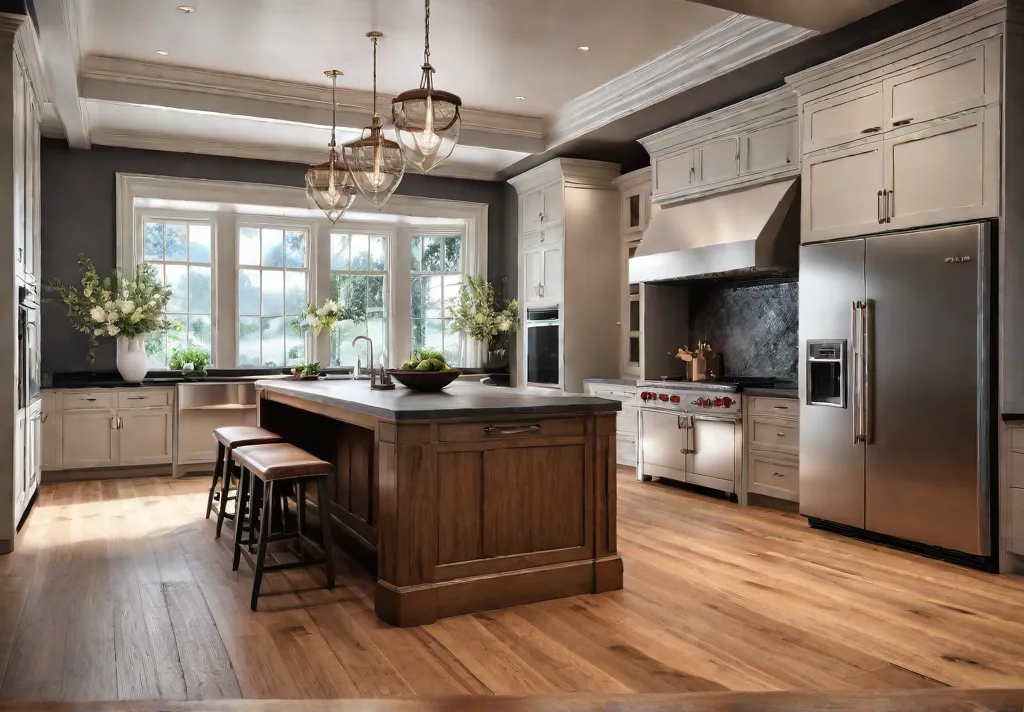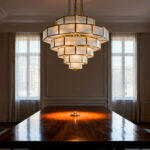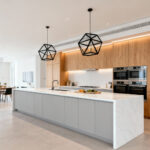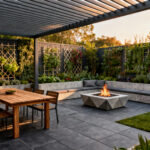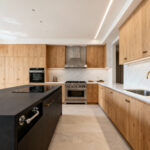Imagine your kitchen not just as a space for cooking but as a canvas to express your creativity and personal style. In traditional kitchen design, few materials can rival wood’s warmth, character, and versatility. When you step into a wood-adorned kitchen, you’re enveloped in a sense of comfort and timeless elegance that only nature’s finest materials can provide.
You can select the perfect wood type to bring your culinary haven to life like a masterful artist. Will you choose the bold, distinctive grain patterns of oak, the refined elegance of maple, or the rich, reddish hues of cherry? Each wood variety offers its unique personality, waiting to be woven into the tapestry of your dream kitchen.
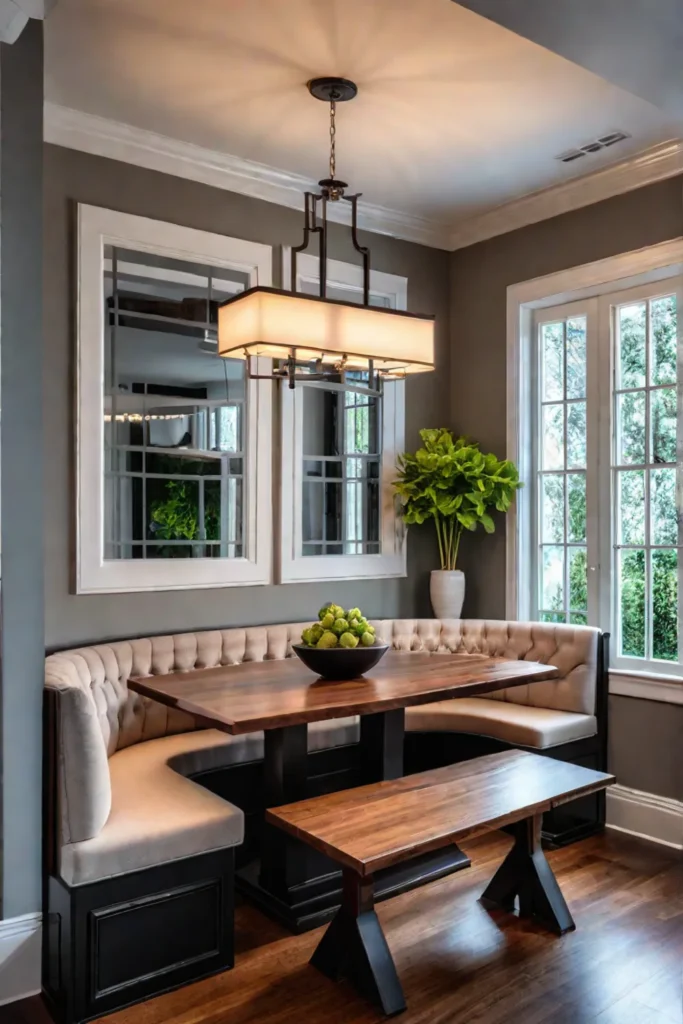
As you embark on this journey, let’s explore the alluring world of wood in traditional kitchen design, where every grain pattern tells a story, and every surface invites you to create lasting memories.
The Enduring Appeal of Wood in traditional kitchens
Imagine returning to the cozy, colonial-era kitchens of early America. The air is filled with the aroma of freshly baked bread and the gentle crackle of a wood-burning stove. Surrounding you are warm, inviting surfaces crafted from the finest woods, each a testament to the artistry and craftsmanship of bygone eras.
This timeless connection between wood and traditional kitchen design has endured for centuries, and good reason. Wood’s natural beauty and versatility have made it an enduring choice for homeowners seeking to create a space that exudes warmth, character, and homeliness.
Beyond its aesthetic appeal, wood also offers unparalleled durability and longevity. Unlike synthetic materials that can fade or deteriorate over time, well-maintained wood surfaces develop a rich patina that only adds to their charm and character. It’s no wonder that many of the world’s most iconic traditional kitchens feature wood as the star of the show.
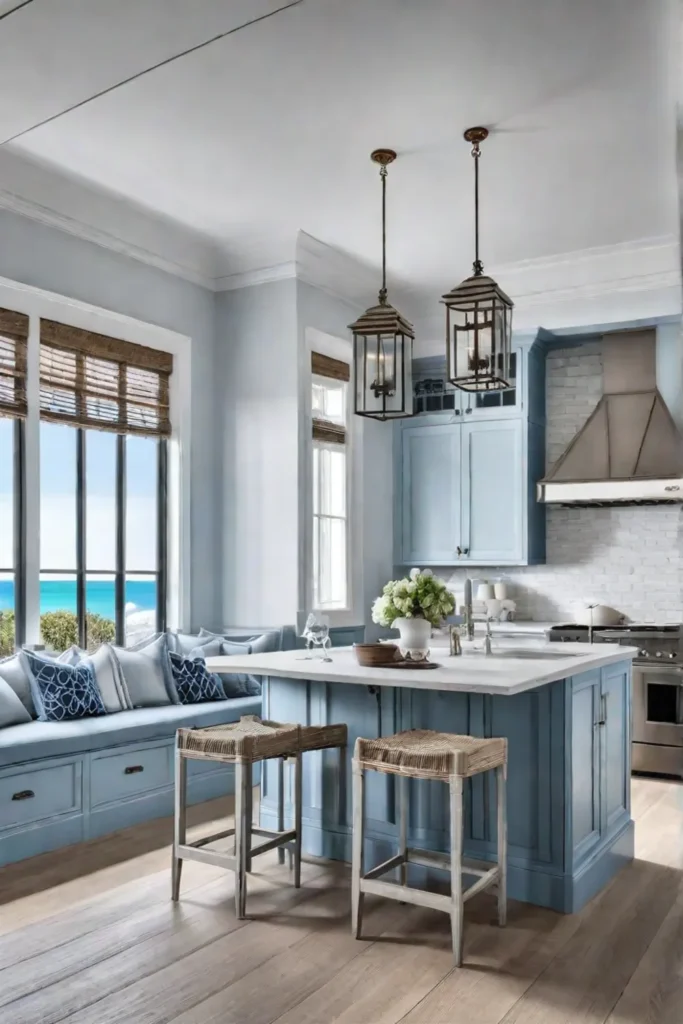
Whether you’re drawn to the rustic allure of exposed beams, the cozy embrace of wood cabinetry, or the inviting warmth of hardwood flooring, wood has a remarkable ability to transform a functional kitchen into a welcoming, lived-in space that feels like an extension of your family’s heritage.
Exploring the Top Wood Choices for Traditional Kitchens
You’ll be spoiled for choice when selecting the perfect wood for your traditional kitchen design. Each wood variety offers unique characteristics, from bold grain patterns to rich color variations, making the decision exciting and potentially overwhelming.
To help you navigate this world of natural beauty, let’s explore five of the most popular wood choices for traditional kitchens: oak, maple, cherry, walnut, and hickory.
Oak: A Timeless Classic with a Bold Character
Look no further than oak if you’re seeking a wood that exudes timeless sophistication and undeniable character. With its distinctive grain patterns ranging from the bold, linear patterns of white oak to the intricate, swirling patterns of red oak, oak has been a staple in traditional kitchen design for centuries.
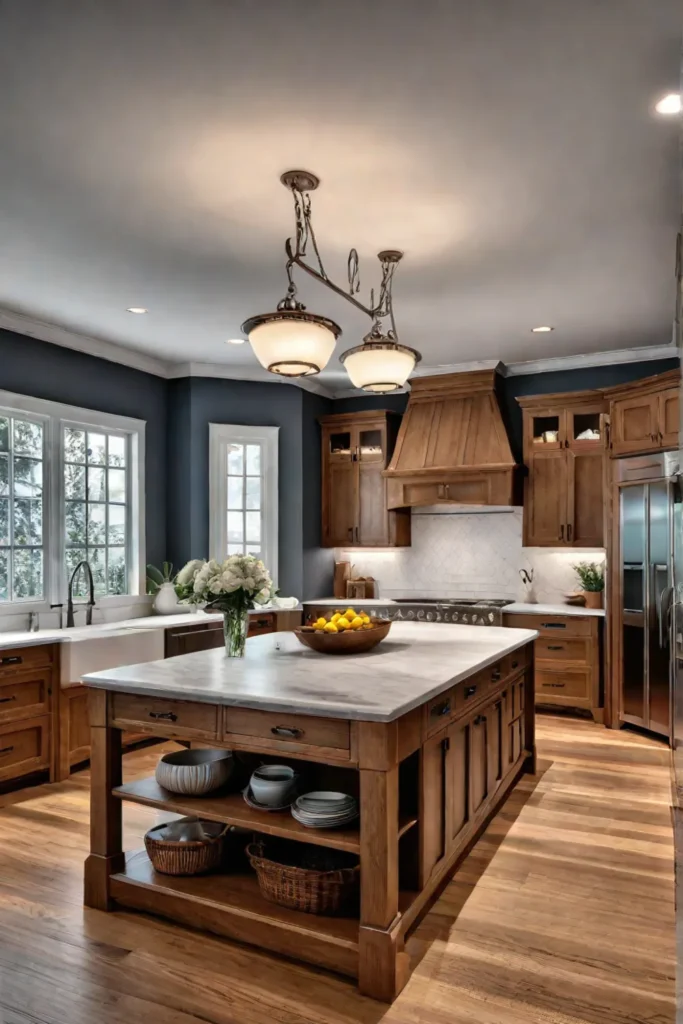
Beyond its visual appeal, oak is also renowned for its exceptional strength and durability, making it an ideal choice for high-traffic areas like kitchen floors and cabinetry. Whether you prefer the warm, golden tones of white oak or the rich, reddish hues of red oak, this versatile wood can seamlessly complement a wide range of traditional kitchen styles.
Maple: Understated Elegance with Exceptional Hardness
Maple is a natural choice for those seeking a refined, understated elegance in their traditional kitchen. With its light, uniform appearance, and fine, subtle grain, maple offers a sense of airiness and sophistication that can elevate even the most modest of spaces.
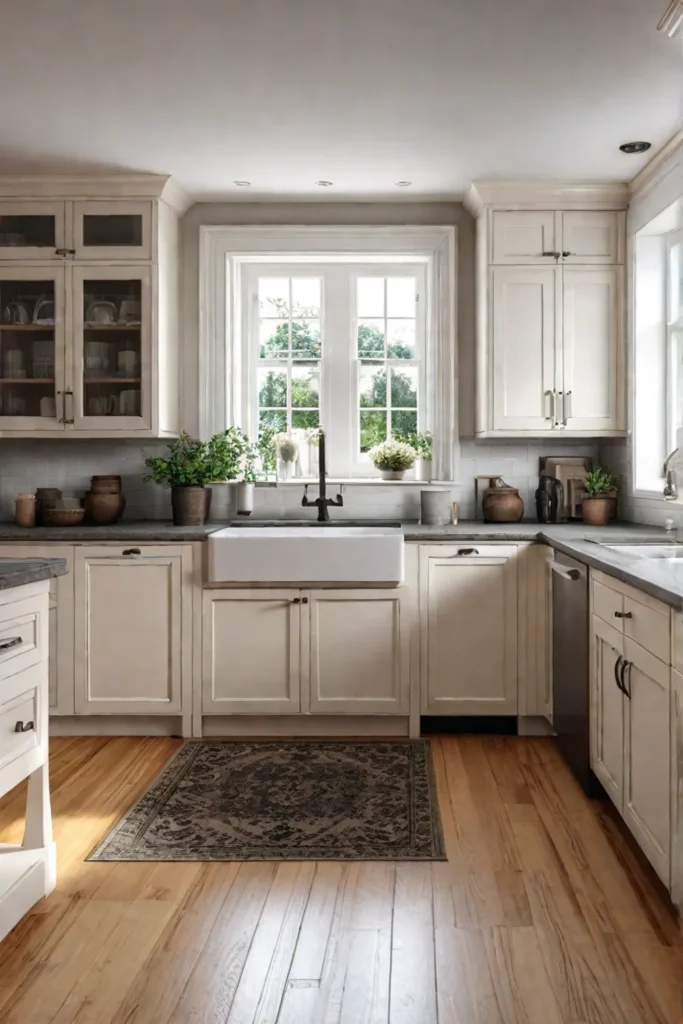
But don’t let its delicate appearance fool you – maple is one of the hardest and most durable wood varieties available, making it an excellent choice for high-traffic areas like kitchen countertops and cutting boards. Its tight grain pattern and exceptional hardness also make it resistant to scratches and dents, ensuring your kitchen surfaces maintain a pristine appearance for years.
Cherry: Warm and Inviting with a Touch of Luxury
If you’re drawn to the idea of a warm, inviting kitchen with a touch of luxury, cherry is a wood that truly shines. With its distinctive reddish-brown hue and unique grain patterns, cherry has long been associated with fine furniture and cabinetry, often gracing the interiors of stately homes and historic buildings.
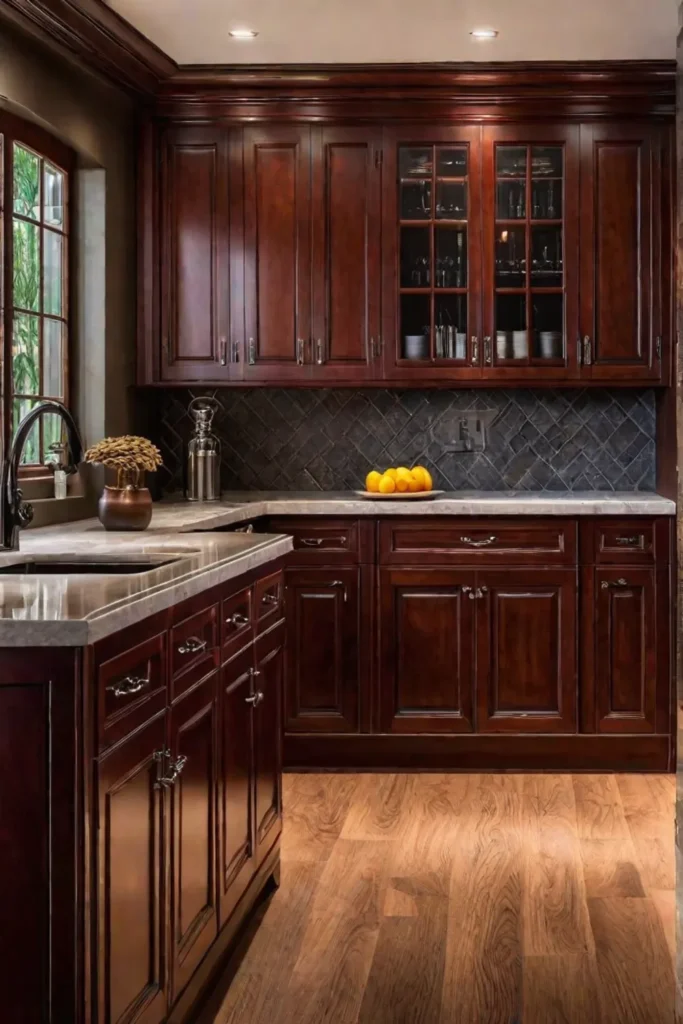
One of the most captivating aspects of cherry is its ability to develop a rich, reddish-brown patina over time, adding depth and character to your kitchen surfaces. This aging process makes cherry so special – each piece becomes a one-of-a-kind work of art, telling the story of your culinary adventures and family gatherings.
Walnut: Rustic Elegance with Depth and Sophistication
For those seeking a balance of rustic charm and sophisticated elegance, walnut is a wood that truly delivers. With its deep, chocolate-brown hue and bold grain patterns, walnut exudes a sense of warmth and depth that can transform even the most modest kitchens into a refined luxury space.
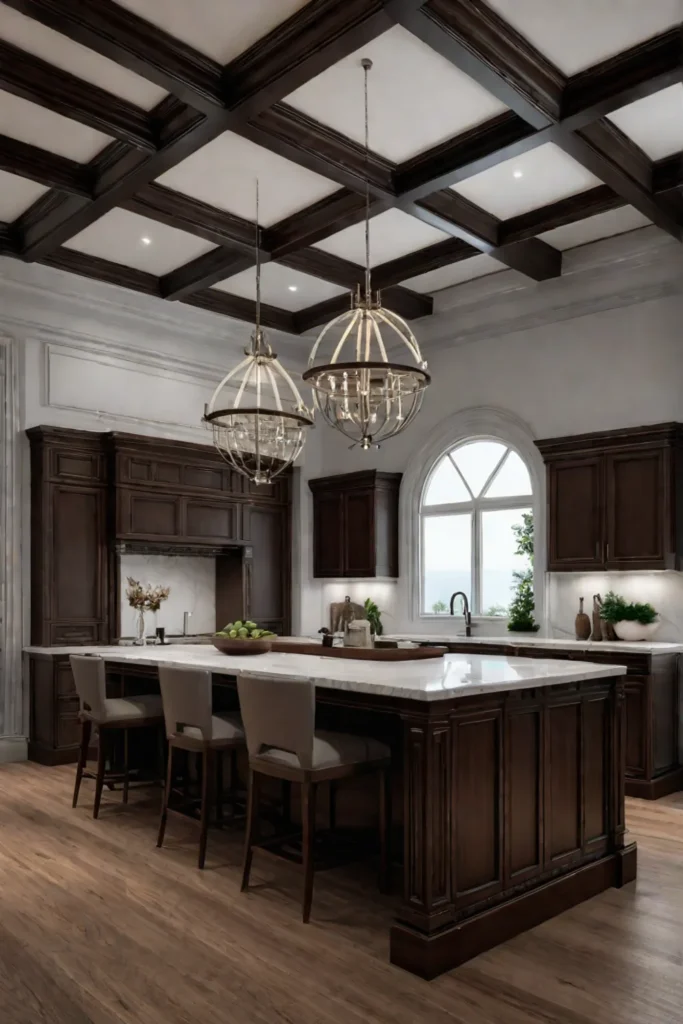
Beyond its visual appeal, walnut is also prized for its natural oil content, which makes it a durable and moisture-resistant choice for kitchen applications. Whether you incorporate walnut into your cabinetry, countertops, or flooring, this rich, versatile wood will surely add a touch of rustic sophistication to your traditional kitchen design.
Hickory: Strength and Character for the Adventurous Spirit
If you’re seeking a wood that truly stands out from the crowd, hickory is a lesser-known but highly durable option that can add a unique touch of character to your traditional kitchen. With its bold grain patterns and natural color variations, hickory offers a visually striking, unique appearance that is sure to turn heads.
But hickory is more than just a beautiful aesthetic choice – it’s also renowned for its exceptional strength and resistance to wear and tear. This makes it an ideal choice for high-traffic areas like kitchen floors or cabinetry, ensuring your surfaces can withstand the demands of a busy culinary haven.
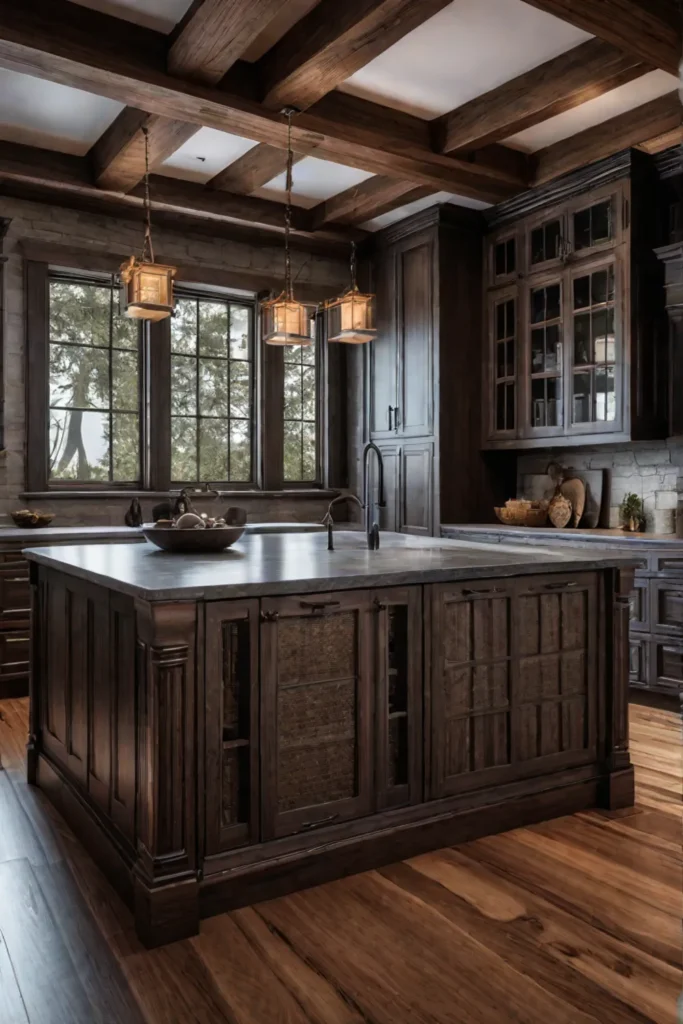
Whether you embrace hickory’s natural variations or a more uniform finish, this rugged and resilient wood will surely add a touch of rustic charm and character to your traditional kitchen design.
Selecting the Perfect Wood for Your Dream Kitchen
With so many stunning wood options to choose from, selecting the perfect one for your traditional kitchen can feel both exciting and daunting. But fear not—by considering a few key factors, you can navigate this decision with confidence and create a space that truly reflects your personal style and practical needs.
First and foremost, consider the overall aesthetic you’re hoping to achieve. Are you drawn to the warm, cozy embrace of rich, reddish-brown tones? Or do you prefer the light, airy feel of a more understated wood like maple? Perhaps you’re seeking a balance of rustic charm and refined elegance, so walnut or hickory could be the perfect fit.
Next, think about the layout and lighting of your kitchen. Lighter woods like maple can help create a sense of openness and brightness, while darker woods like walnut or cherry can add depth and drama to a space with ample natural light.
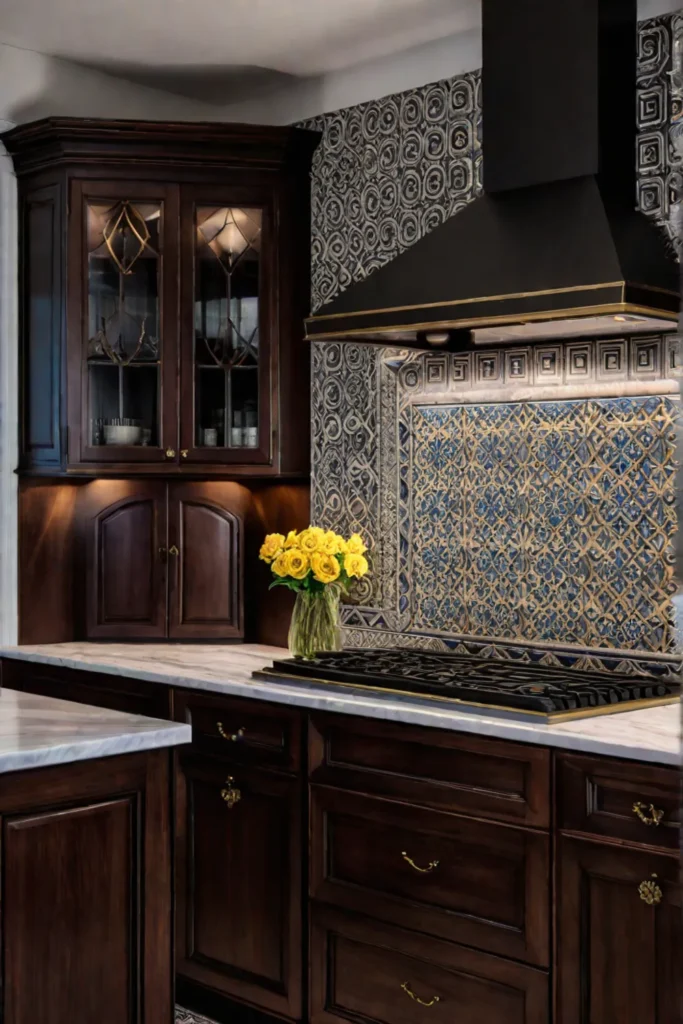
Durability and maintenance requirements are also crucial considerations, especially in a high-traffic area like a kitchen. If you have an active household with young children or pets, you may want to opt for a harder, more scratch-resistant wood like maple or hickory. On the other hand, if you’re willing to invest in regular maintenance, the rich cherry or walnut patina could be a stunning choice.
Finally, remember to consider the overall design aesthetic you’re striving for. If you aim for a cohesive, timeless look, you’ll want to coordinate your wood choice with other design elements like countertops, backsplashes, and hardware. Wood that complements these features can create a harmonious, visually appealing space that feels like an extension of your style.
Embracing the Natural Beauty of Oak
As we’ve explored the various wood options for traditional kitchen design, one variety stands out as a true icon: oak. With its rich history and undeniable character, oak has been a beloved choice for centuries, gracing the interiors of some of the world’s most iconic traditional kitchens.
Imagine running your fingers along the bold, linear grain patterns of white oak, each line telling a story of the tree’s journey from sapling to majestic wonder. Or perhaps you’re drawn to red oak’s intricate, swirling patterns, with its warm, reddish hues that seem to dance across the surface like flickering flames.
Beyond its visual appeal, oak is also renowned for its exceptional strength and durability, making it an ideal choice for high-traffic areas like kitchen floors and cabinetry. Whether you incorporate oak into your cabinetry, countertops, or flooring, this timeless wood will surely add a touch of rustic sophistication and character to your traditional kitchen design.

But oak’s beauty extends beyond its physical characteristics. This versatile wood also offers many design opportunities, allowing you to create a space that seamlessly blends tradition and modernity. Imagine pairing sleek, contemporary hardware with the warm, inviting tones of oak cabinetry or contrasting the bold grain patterns of an oak floor with the clean lines of a minimalist kitchen island.
Caring for oak surfaces is a labor of love but one that is well worth the effort. Regular cleaning and applying protective finishes can help preserve this remarkable wood’s natural beauty and longevity, ensuring your traditional kitchen remains a stunning centerpiece for years to come.
So, whether you’re drawn to the bold, linear patterns of white oak or the intricate swirls of red oak, embracing the natural beauty of this timeless wood is a surefire way to create a traditional kitchen that exudes warmth, character, and enduring style.
The Refined Elegance of Maple
Few wood choices can match maple’s refined elegance and understated beauty in traditional kitchen design. With its light, uniform appearance, and fine, subtle grain, maple offers a sense of airiness and sophistication that can elevate even the most modest of spaces.
Imagine stepping into a kitchen adorned with maple cabinetry, the soft, warm tones creating a welcoming embrace that invites you to linger and savor each culinary moment. Or envision a stunning maple countertop, its smooth surface providing the perfect canvas for your culinary artistry. At the same time, its exceptional hardness ensures it can withstand the demands of a busy kitchen.
But maple’s allure extends beyond its aesthetic appeal. This remarkable wood is also renowned for its exceptional durability and resistance to wear and tear, making it an ideal choice for high-traffic areas like kitchen floors, countertops, and cutting boards.
As you explore the design possibilities of maple, you’ll discover a world of opportunities to create a space that seamlessly blends tradition and modernity. Imagine pairing sleek, contemporary hardware with the warm, inviting tones of maple cabinetry or contrasting a maple island’s light, airy feel with the rich, earthy tones of a hardwood floor.
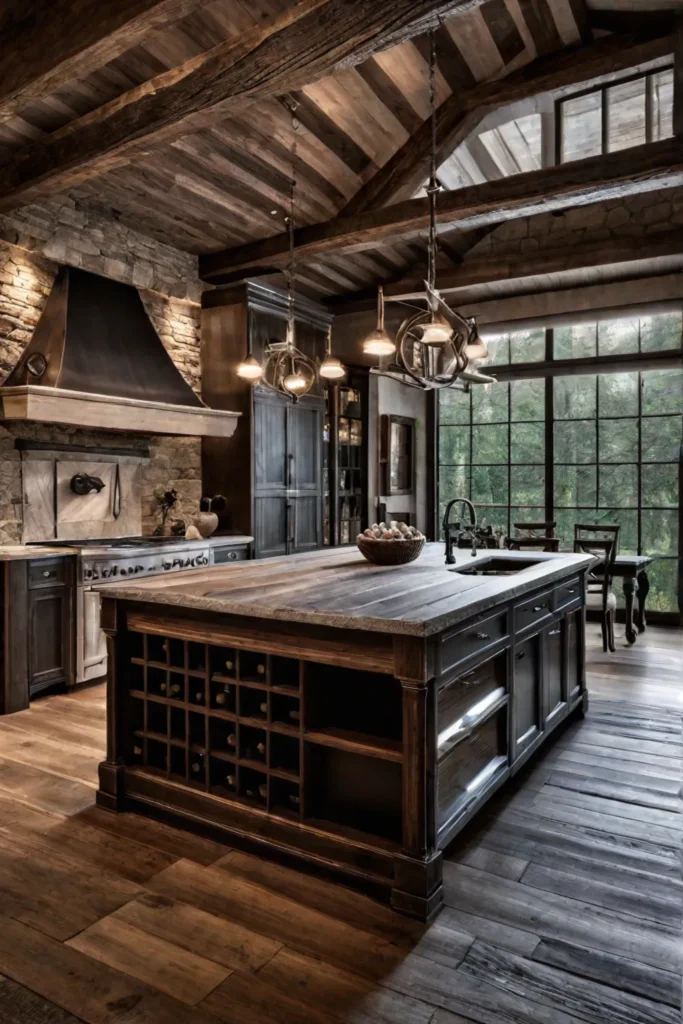
Caring for maple surfaces is straightforward, with regular cleaning and the application of protective sealants being the key to preserving their natural beauty and longevity. As the years pass, the subtle grain patterns and warm tones of maple will only grow more captivating, creating a sense of timeless elegance that will never go out of style.
So, whether you’re drawn to maple’s light, airy feel or simply appreciate its exceptional durability and versatility, this remarkable wood is a true gem in the world of traditional kitchen design, offering a refined and elegant canvas for your culinary adventures.
The Warm Charm of Cherry
Few woods can match the warm, inviting charm of cherry in traditional kitchen design. With its distinctive reddish-brown hue and unique grain patterns, cherry has long been associated with fine furniture and cabinetry, often gracing the interiors of stately homes and historic buildings.
Imagine stepping into a kitchen adorned with cherry cabinetry, the rich, warm tones enveloping you in a cozy embrace that instantly puts you at ease. Or envision a stunning cherry island, its smooth surface providing the perfect gathering place for family and friends. At the same time, the unique grain patterns add natural artistry to the space.
But cherry’s allure extends far beyond its visual appeal. This remarkable wood is also prized for its ability to develop a rich, reddish-brown patina over time, adding depth and character to your kitchen surfaces. Each year, the cherry in your kitchen will become a living testament to the memories and culinary adventures you’ve shared within its walls.
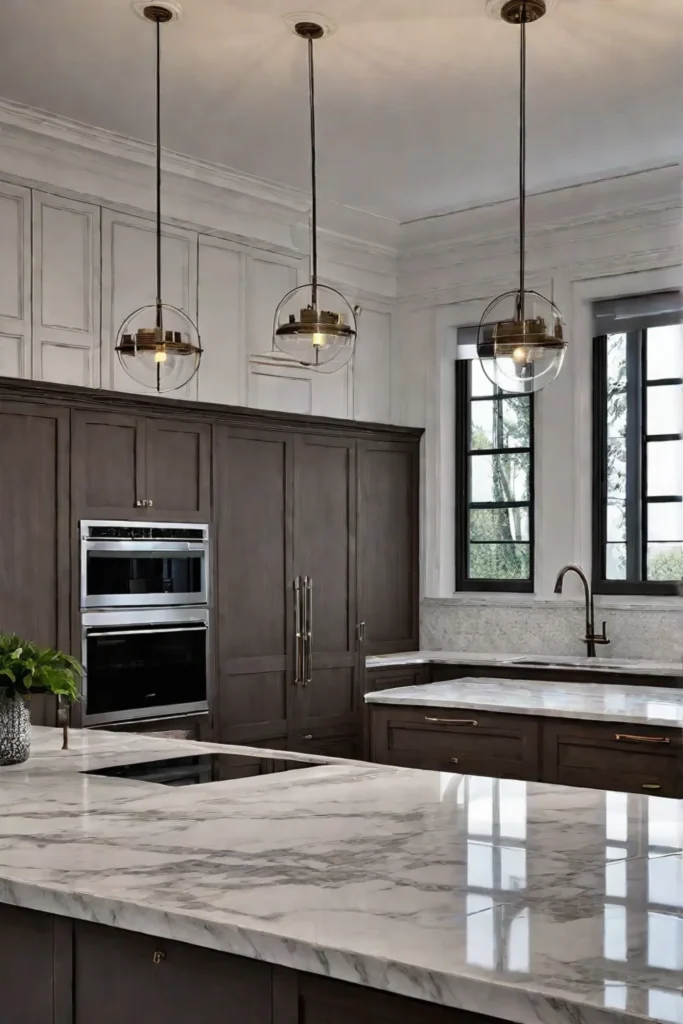
As you explore the design possibilities of cherry, you’ll discover a world of opportunities to create a space that seamlessly blends tradition and warmth. Imagine pairing sleek, contemporary hardware with the inviting tones of cherry cabinetry or contrasting the rich, reddish hues of a cherry island with the cool, crisp tones of a subway tile backsplash.
Caring for cherry surfaces is a labor of love, but it is well worth the effort. Regular cleaning and applying conditioning oils can help preserve this remarkable wood’s natural luster and warmth, ensuring your traditional kitchen remains a stunning centerpiece for years to come.
So, whether you’re drawn to the cozy embrace of cherry or appreciate its ability to develop a rich, timeless patina, this remarkable wood is a true gem in traditional kitchen design, offering a warm and inviting canvas for your culinary adventures.
The Rustic Elegance of Walnut
Few woods can match the elegance and depth of walnuts in traditional kitchen designs. With their deep, chocolate-brown hue and bold grain patterns, walnut exudes a sense of warmth and sophistication that can transform even the most modest kitchen into a space of refined luxury.
Imagine stepping into a kitchen adorned with walnut cabinetry. The rich, earthy tones create a cozy embrace that invites you to linger and savor each culinary moment. Or envision a stunning walnut countertop. Its smooth surface provides the perfect canvas for your culinary artistry, while the bold grain patterns add a touch of natural artistry to the space.
But walnut’s allure extends far beyond its visual appeal. This remarkable wood is also prized for its natural oil content, which makes it a durable and moisture-resistant choice for kitchen applications. Whether you incorporate walnut into your cabinetry, countertops, or flooring, this rich, versatile wood will surely add a touch of rustic sophistication to your traditional kitchen design.
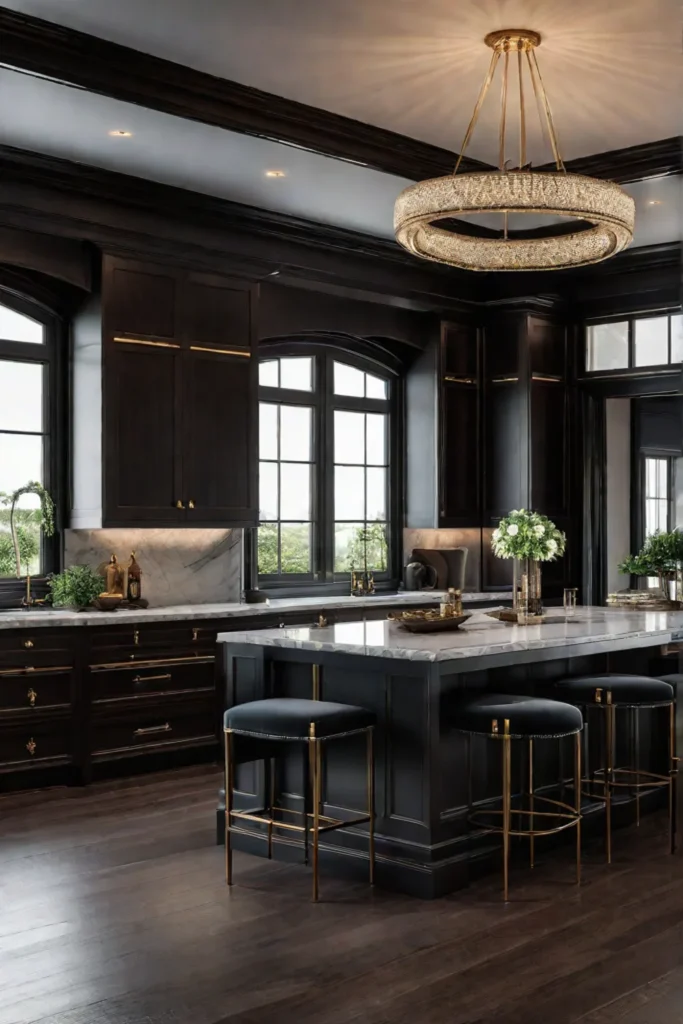
As you explore the design possibilities of walnuts, you’ll discover a world of opportunities to create a space that seamlessly blends tradition and modernity. Imagine pairing sleek, contemporary hardware with the warm, inviting tones of walnut cabinetry or contrasting the rich, chocolate-brown hues of a walnut island with the cool, crisp tones of a marble backsplash.
Caring for walnut surfaces is a straightforward endeavor, with regular cleaning and applying specialized products being the key to preserving its natural beauty and longevity. As the years pass, the bold grain patterns and rich walnut tones will grow more captivating, creating a timeless elegance that will never go out of style.
So, whether you’re drawn to walnut’s rustic charm or appreciate its exceptional durability and versatility, this remarkable wood is a true gem in traditional kitchen design, offering a sophisticated and inviting canvas for your culinary adventures.
The Strength and Character of Hickory
In the ever-evolving world of traditional kitchen design, one wood stands out as a true maverick – hickory. With its bold grain patterns and natural color variations, hickory offers a visually striking and one-of-a-kind appearance that will turn heads and capture the imagination of even the most discerning homeowners.
Imagine stepping into a kitchen adorned with hickory cabinetry, the rich, varied tones creating a warm and inviting embrace that instantly puts you at ease. Or envision a stunning hickory island, its smooth surface providing the perfect gathering place for family and friends while the unique grain patterns add a touch of rustic charm and character to the space.
But hickory’s allure extends far beyond its visual appeal. This remarkable wood is also renowned for its exceptional strength and resistance to wear and tear, making it an ideal choice for high-traffic areas like kitchen floors or cabinetry. Whether you embrace hickory’s natural variations or a more uniform finish, this rugged and resilient wood can withstand the demands of even the busiest culinary haven.
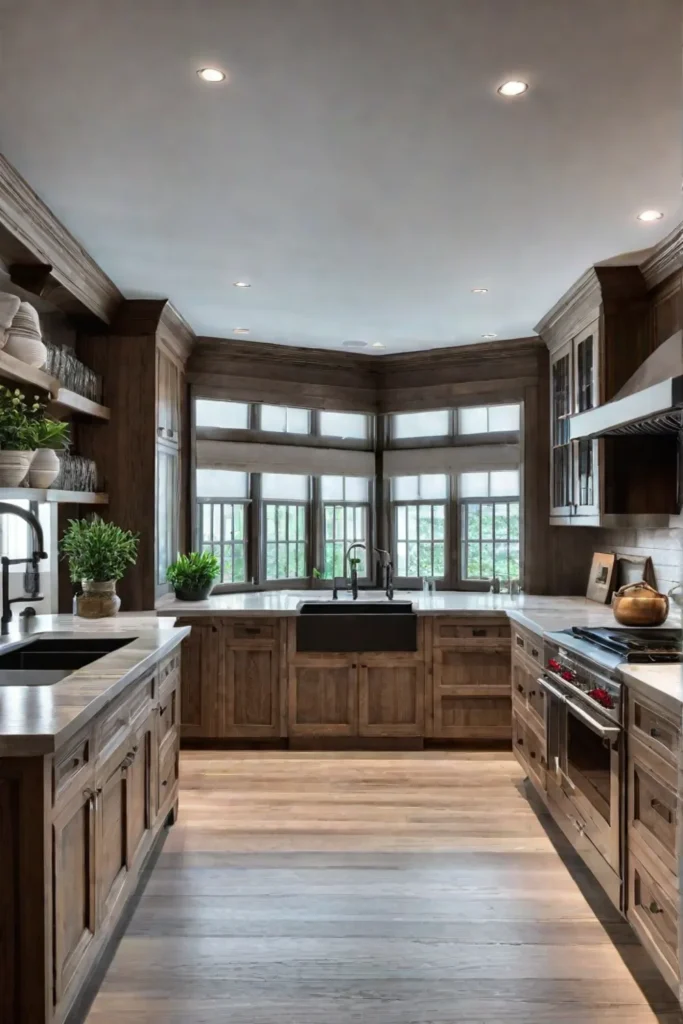
As you explore the design possibilities of hickory, you’ll discover a world of opportunities to create a space that seamlessly blends tradition and adventure. Imagine pairing sleek, contemporary hardware with the rustic tones of hickory cabinetry or contrasting the bold grain patterns of a hickory island with the cool, crisp tones of a subway tile backsplash.
Caring for hickory surfaces is a straightforward endeavor, with regular cleaning and applying specialized products being the key to preserving its natural beauty and longevity. As the years pass, the unique grain patterns and varied tones of hickory will only grow more captivating, creating a sense of timeless character that will never go out of style.
So, whether you’re drawn to Hickory’s rustic charm or appreciate its exceptional strength and durability, this remarkable wood is a true gem in traditional kitchen design, offering an adventurous and inviting canvas for your culinary adventures.
A Timeless Love Affair with Wood in the Heart of Your Home
As we’ve explored the captivating world of wood in traditional kitchen design, it’s clear that this enduring love affair is far from over. From the bold, distinctive grain patterns of oak to the refined elegance of maple, the warm, inviting charm of cherry to the rustic sophistication of walnut, and the adventurous spirit of hickory – each wood variety offers its unique personality and character, waiting to be woven into the tapestry of your dream kitchen.
Choosing the perfect wood for your traditional kitchen is a deeply personal journey that reflects your style, practical needs, and the cherished memories you hope to create within this beloved space. Whether you’re drawn to the timeless appeal of oak, the understated beauty of maple, the cozy embrace of cherry, the rustic charm of walnut, or the striking character of hickory – your chosen wood will serve as the heartbeat of your kitchen, infusing it with warmth, comfort, and an inviting ambiance that will stand the test of time.
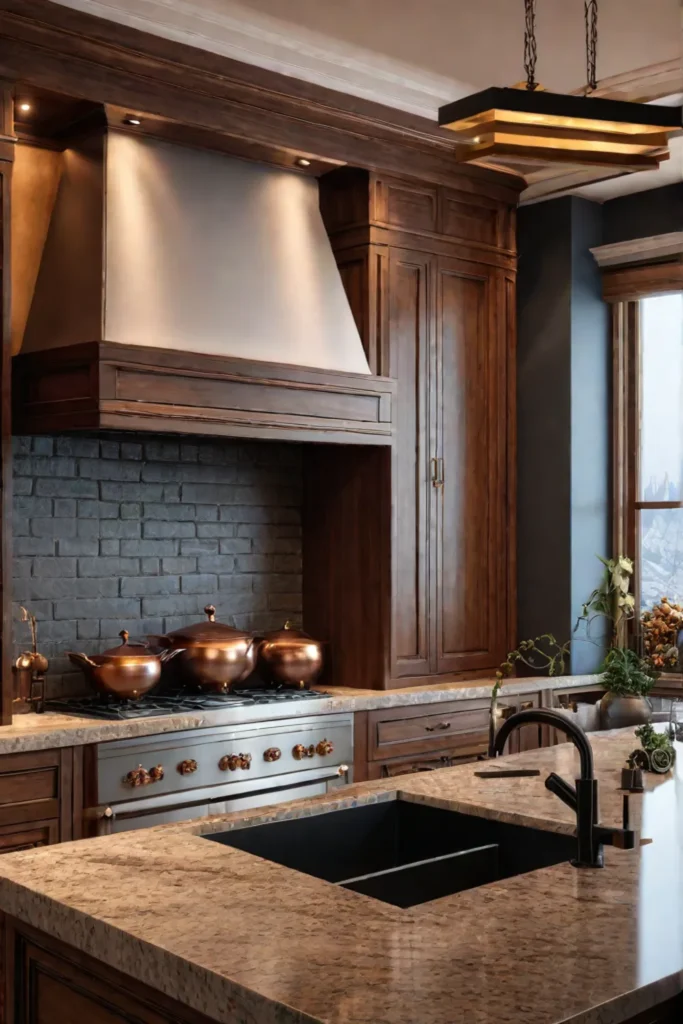
As you embark on this exciting journey of creating your dream kitchen, remember that the beauty of wood lies not only in its visual appeal but also in its ability to tell a story. Every year, the wood surfaces in your kitchen will develop a rich patina, bearing witness to the laughter, love, and culinary adventures that unfold within its walls. Your chosen wood will become a part of your family’s legacy, a testament to your home’s timeless beauty and enduring spirit.
So, as you step into your new kitchen, take a moment to appreciate the natural wonder of the wood surrounding you. Run your fingers along the grain, feel the warmth and character emanating from each surface, and know that you’ve created a space uniquely yours – a traditional kitchen that will be cherished for generations to come.
